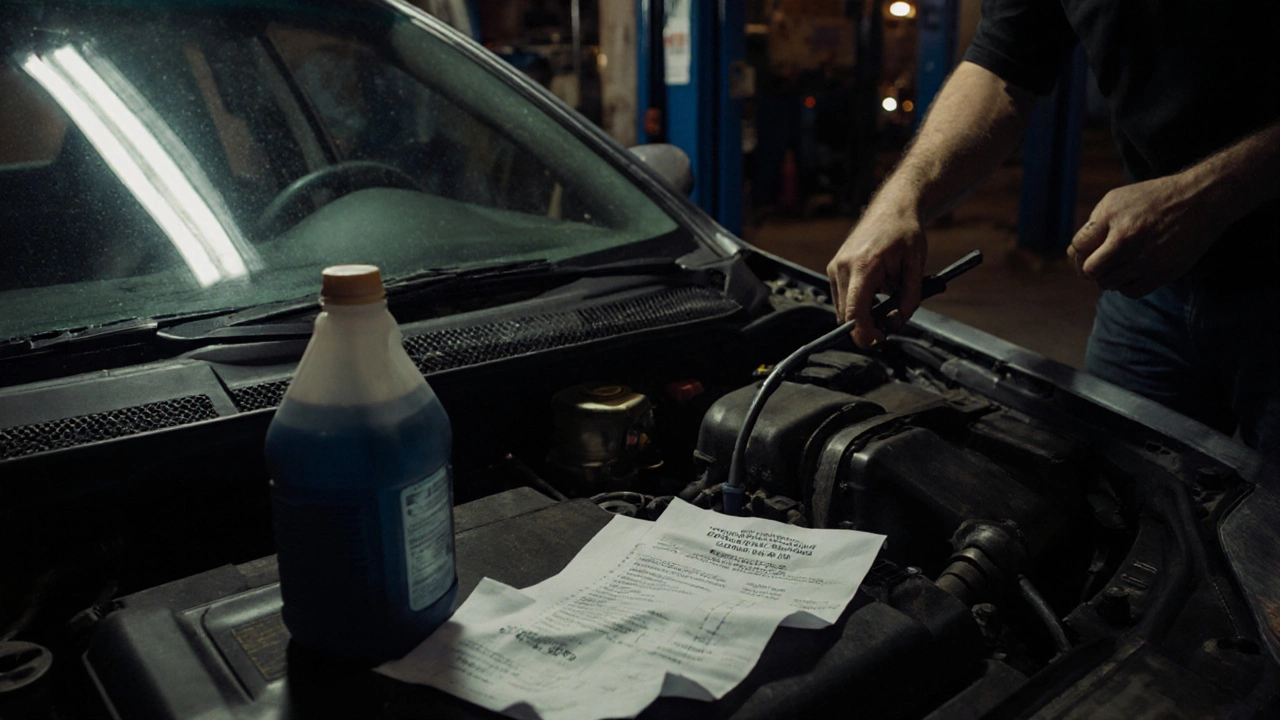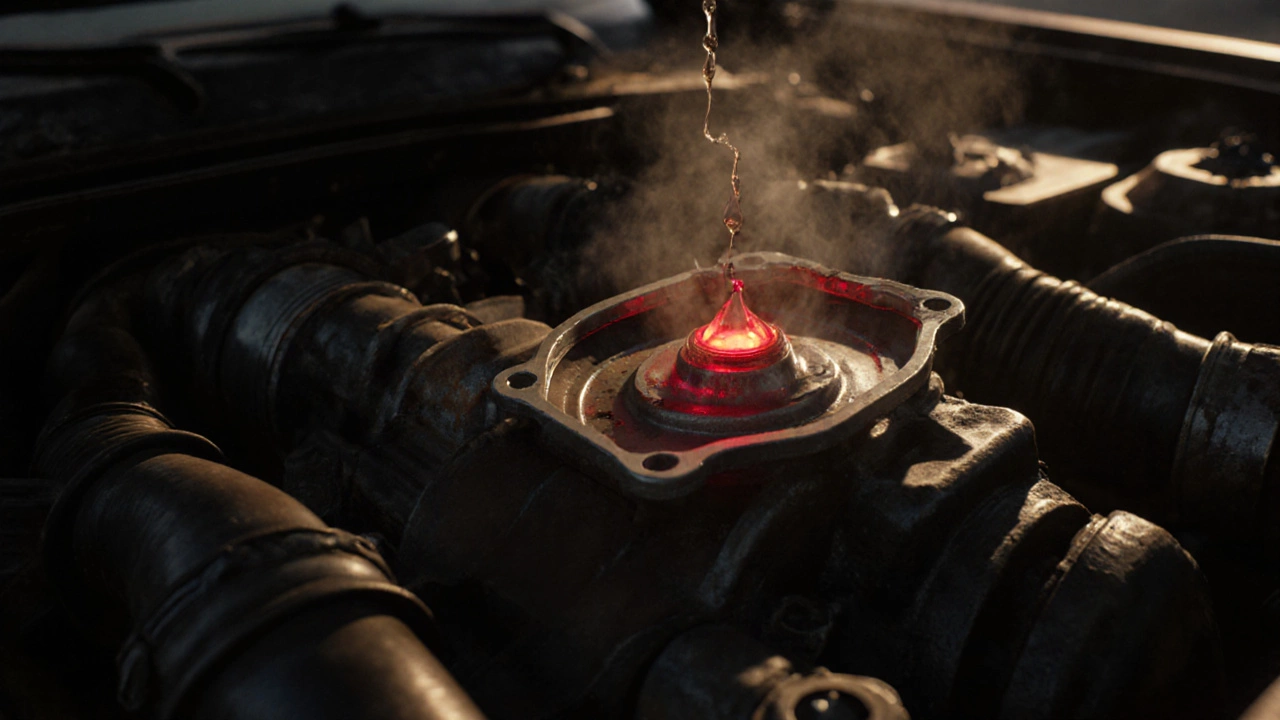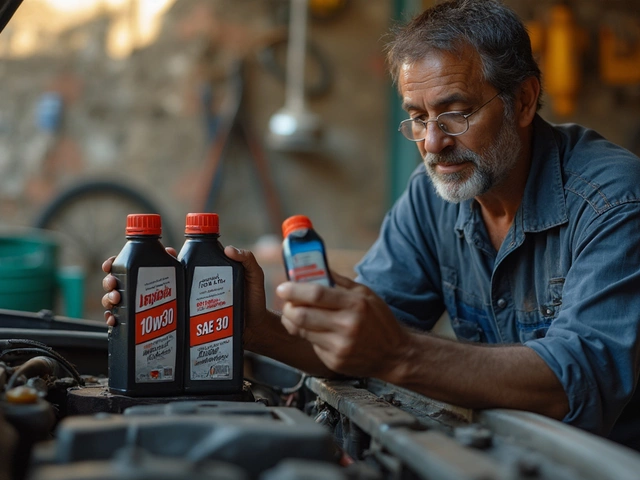Engine Oil Level Checker
Engine Oil Safety Check
Enter your engine's oil capacity and current oil level to determine if your oil is at a safe level and how much to add.
Oil Level Status
When your car’s engine oil is low, it’s not just a minor inconvenience-it’s a ticking time bomb. You might ignore the warning light or think, "It’s just a little low, I’ll top it off later." But that "later" could cost you thousands in repairs-or worse, leave you stranded on the side of the road.
Why Engine Oil Matters
Engine oil isn’t just a lubricant. It’s the lifeblood of your engine. It reduces friction between moving metal parts like pistons, crankshafts, and camshafts. It also cools components that coolant can’t reach, cleans out sludge and debris, and seals gaps between piston rings and cylinder walls. Without enough oil, these jobs don’t get done.
Modern engines run tighter tolerances than ever. That means even a small drop in oil level can mean big problems. Most engines need at least 4 to 6 quarts to operate safely. If you’re down by a full quart or more, you’re already in danger zone.
What Happens Right Away When Oil Is Low
The first sign? The oil pressure warning light. It’s not a suggestion-it’s an emergency signal. When oil levels drop, the oil pump can’t pull enough fluid to maintain pressure. That triggers the light, usually shaped like a dripping oil can.
At this point, you’re not just risking damage-you’re already causing it. Metal parts that should glide smoothly start grinding. You might hear knocking, ticking, or rattling noises from the engine. These sounds come from lifters, valves, or rod bearings losing their oil cushion. The noise gets louder as the oil level drops further.
Some drivers think the engine will just shut off before it fails. That’s not guaranteed. Many engines keep running even with dangerously low oil-until they suddenly seize. And when that happens, there’s no warning. One moment it’s running fine; the next, it’s dead.
Short-Term Consequences: Overheating and Wear
Oil helps absorb and carry away heat. When levels are low, the engine can’t cool properly. Components like the turbocharger, which spins at over 100,000 RPM, rely heavily on oil for cooling. A turbo running without enough oil can overheat in minutes and fail completely.
Even if the engine doesn’t seize right away, low oil causes accelerated wear. Bearings, camshafts, and cylinder walls start to score. These aren’t cheap parts to replace. A damaged main bearing can cost $1,500 to fix. A ruined turbo? That’s another $2,000.
And here’s the kicker: this damage builds up silently. You might not notice it until you’re halfway through a long trip and the engine starts misfiring or losing power. By then, it’s too late to reverse the damage.

Long-Term Damage: The Silent Killer
Many people think low oil only causes immediate failure. But the real danger is the slow, invisible destruction. Every time you drive with low oil, you’re wearing down your engine a little more. Over weeks or months, that adds up.
Think of it like running a marathon with worn-out shoes. You can keep going-but your feet are getting battered. Same with your engine. The tiny metal particles from worn bearings and cylinder walls mix into the remaining oil. That creates abrasive sludge that scratches more surfaces. It’s a feedback loop of destruction.
Studies from the Society of Automotive Engineers show that engines running with 20% less oil than recommended can lose up to 40% of their expected lifespan. That’s not a guess-it’s lab-tested data. A 200,000-mile engine might die at 120,000 if oil levels are consistently low.
What Low Oil Looks Like in Real Life
Take Sarah, a teacher in Ohio. She drove her 2018 Honda Civic for 1,200 miles between oil changes, ignoring the warning light because "it went off after a few miles." She thought it was a glitch. After a 300-mile road trip, her engine locked up on the highway. She didn’t even notice the noise until it was too late.
Her repair bill? $4,200 for a rebuilt engine. She could’ve topped off the oil for $15.
Or consider Mark, a delivery driver. He checked his oil every two weeks but never looked at the dipstick properly. He thought the level was fine because the light wasn’t on. Turns out, his car was burning oil from worn piston rings. By the time he noticed, the engine had 80,000 miles of silent wear. He replaced the engine with a used one for $2,800. He now checks his oil every time he fills up.
How to Check Oil Correctly
Checking oil isn’t hard-but most people do it wrong.
- Turn off the engine and wait 5 minutes. Oil needs to drain back into the pan.
- Pull the dipstick, wipe it clean with a rag.
- Reinsert it fully, then pull it out again.
- Look at the two marks on the stick: "Min" and "Max." Oil should be between them.
- If it’s at or below the min mark, add half a quart. Recheck.
Never check oil while the engine is running. It gives false readings. And never rely on the dashboard warning light alone. It only comes on when oil pressure is already dangerously low. By then, damage has started.

What to Do If Oil Is Low
If you find your oil is low:
- Don’t drive more than necessary. Get to a safe spot.
- Add the right type of oil. Check your owner’s manual for viscosity (like 5W-30) and API rating.
- Don’t mix brands or types unless it’s an emergency. Synthetic and conventional oils can be mixed in a pinch, but it’s not ideal.
- After topping off, get the leak or burn issue checked. Low oil is rarely just a coincidence.
Most of the time, low oil means one of three things: a leak, burning oil, or not changing it often enough. A leak might be from a loose drain plug, worn gasket, or cracked oil pan. Burning oil usually points to worn piston rings or valve seals. Both need professional diagnosis.
Prevention: The Only Real Solution
The best way to avoid low oil problems? Make checking it part of your routine.
Check your oil every time you fill up with gas. That’s about once a week for most drivers. It takes 30 seconds. You’ll catch a leak before it turns into a disaster. You’ll know if your car is burning oil early enough to plan for repairs.
Also, stick to your oil change schedule. Most modern cars need oil changes every 7,500 to 10,000 miles. But if you drive in dusty conditions, haul heavy loads, or frequently idle (like delivery drivers), cut that to 5,000 miles.
And if your car is older than 10 years or has over 100,000 miles? Check the oil weekly-even if you’re on schedule. Older engines tend to burn more oil.
Final Warning: Don’t Wait for the Light
The oil warning light is the last line of defense. It doesn’t prevent damage-it just tells you it’s already happening. Relying on it is like waiting for your smoke alarm to go off before you notice your house is on fire.
Low engine oil doesn’t just hurt your wallet. It can leave you stranded, cause accidents, or destroy an engine you’ve relied on for years. The cost of prevention? A bottle of oil and five minutes of your time.
The cost of ignoring it? Thousands of dollars and the loss of your vehicle.
Can low engine oil cause the check engine light to come on?
Yes. Low oil pressure can trigger the check engine light because it affects engine performance. The car’s computer detects abnormal sensor readings-like low oil pressure or increased friction-and logs a code. Common codes include P0521 (oil pressure sensor range/performance) or P0522 (oil pressure too low). But the check engine light isn’t specific to oil-it could mean many things. Always check the oil level first if the light comes on.
How often should I check my engine oil?
Check it every time you fill up with gas. That’s about once a week for most drivers. If your car is older, has high mileage, or you notice oil consumption (like needing to top off every few weeks), check it twice a week. Modern cars don’t need daily checks, but weekly checks catch problems early.
Can I drive with low engine oil for a short distance?
It’s risky. Even driving a few miles with oil below the minimum mark can cause damage. If you’re only a quarter-quart low and need to get to a gas station, go slowly and avoid hard acceleration. But if the oil is below the min line or the warning light is on, stop driving immediately. Turn off the engine and call for help.
What happens if I add too much oil?
Overfilling oil can be just as bad as running low. Too much oil creates excess pressure in the crankcase, which can blow out seals and gaskets. It can also cause the crankshaft to whip the oil into foam, reducing lubrication. Foam doesn’t flow properly, leading to the same damage as low oil. Always follow the dipstick marks-don’t go above "Max."
Does synthetic oil last longer than conventional oil?
Yes, synthetic oil lasts longer and performs better under stress. It resists thinning at high temperatures and thickening in cold weather. It also breaks down slower, meaning you can often go 10,000 miles between changes instead of 5,000. But even synthetic oil needs to be checked regularly. It doesn’t stop leaks or burning-it just lasts longer before it degrades.
If you’ve ever wondered why mechanics always ask, "When was your last oil change?"-now you know. It’s not just routine. It’s the most important thing you can do to keep your engine alive.




